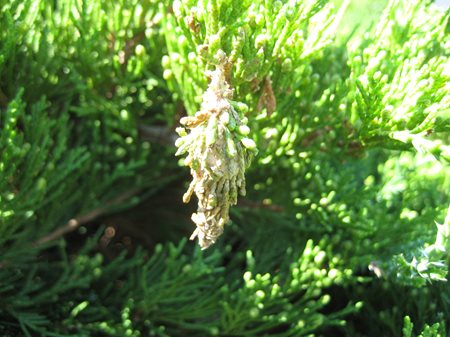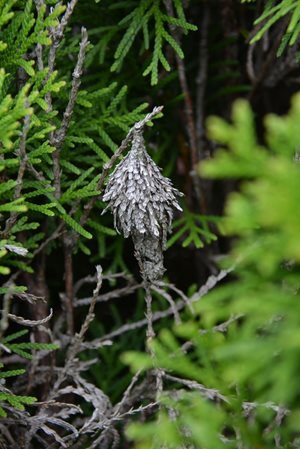What are Bagworms?
Bagworms are most destructive to evergreen trees like arborvitae, juniper, pine, spruce, and many others. They can also attack deciduous trees such as black locust, honey locust, and sycamore trees.

What do they look like?
The insect is most recognized by the bag or case that the caterpillar suspends from the host plant, which is made of silk and little bits of foliage from the plant that helps to strengthen the case. When the larvae are mature, the bag is anywhere from 30 to 55 mm long. The adult female is about 18 to 25 mm long, and she lacks wings, eyes, functional legs, and mouth parts. She will never leave the bag she constructed as larvae. The males are sooty black and moth-like with transparent wings.
Life Cycle
In late spring and early summer, the eggs hatch. About 500-1000 eggs come from each female. Once hatched, young larvae start to feed and construct cases around their bodies. Over an eight week feeding period, they eat and continually increase the size and strength of their cases. This continues through about August. The mature larvae loop silk around a twig and become firmly attached. They then close the bag and reverse to a head-down position. They stay in this resting stage for about four weeks. In September and early October, males emerge from their cases and fly to female bags where they mate. The females lay anywhere between 500-1,000 eggs, then crawl out of the bag, fall to the ground and die. The eggs remain in the bag to overwinter and hatch the following spring and summer.
Damage
The most damage is done during the 8-week feeding period when they are feeding on needles and leaves. Both young and mature larvae can do harm to plants. Check carefully for the bags when examining plants for infestations as they are very conspicuous. The picture shows that they look like part of the plant. Early detection is crucial to minimize damage.
How can you control bagworms?
Manage this pest by handpicking or cutting the bags from infested plants. Ideally, cut these late fall or early winter before the eggs have hatched. To treat young larvae that are hatched and feeding, use an insecticide labeled for bagworm management in June and July. Be sure to read all the labels on the insecticide and follow instructions carefully.
Have you seen bagworms? Give us a call, we can come take a look and recommend a course of action!


